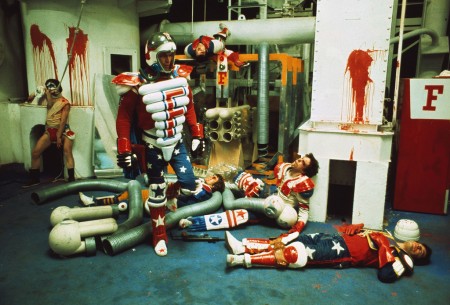
The multifaceted artist William Klein is everything but a conformist. He is in fact its antithesis, making the most of each opportunity he has to question all conventions, be it in the world of photography or film. He craves the eccentric and out of the ordinary, he explores behind the scenes and brings to light the absurd, the forgotten and the rejected. He seeks not to please but rather to provoke; with wit and humor he reveals what others choose to ignore.
Just after World War II, Klein, the 18-year-old Jewish New Yorker was sent to Germany to do his military service. Two years later he went to Paris, where he met the love of his life and future collaborator, Jeanne Florin. He studied painting with Fernand Léger, but soon began his photographic career shooting fashion photos for Vogue (New York) magazine and then moving to street photography. His first book, New York (Life Is Good & Good for You in New York: Trance Witness Revels) changed the course of photography. His innovative choice of subject matter and use of wide-angle lenses, out-of-focus elements, and grainy film were criticized at the time but soon earned him international recognition.
In 1958, encouraged by his friends Chris Marker and Alain Resnais, Klein began his filmmaking adventure with the short Broadway by Light. With Times Square as the stage and the neon signs as ready-mades, Klein created an exquisite collage of words, lights, and abstract images that was considered to be the first Pop movie.
With the swinging sixties came Klein’s first feature film, the luscious Qui êtes-vous, Polly Maggoo? (1966), a satire on the extravagance and superficiality of the media and the fashion world. With a truly unique style, Klein cunningly cuts from one genre to another, from fiction to false documentary, passing through animation, musical comedy, and even a bit of cinéma verité.
As Klein approached his forties, the war in Vietnam was at its peak and he became overtly political. In 1967 he joined with Alain Resnais, Jean-Luc Godard, Agnès Varda, Claude Lelouch, Joris Ivens, and Chris Marker to make the film Loin du Vietnam, a direct attack on U.S. foreign policy.
Long before comic book characters became a trend in film, Klein created Mr. Freedom (1968), which features a superhero who incarnates the United States’ God-like attitude toward the world. This hilarious farce offers an unmerciful critique of the American government as well as other political doctrines such as Maoism and Stalinism. Initially banned in France, it presents a harmonious and yet disturbing explosion of color, violence, and humor.
During the late 1960s, Klein continued to reveal the cracks in the American dream and focused on the general world disillusionment of that era through such films as Grand soirs et petits matins (1968-1978), Festival Panafricain d’Alger (1969), and Eldridge Cleaver, Black Panther (1970). In the latter, Klein portrayed the revolutionary and polemic Eldridge Cleaver who, wanted in the United States, had fled to Algeria in exile. Here we see two of Klein’s traits as a filmmaker: his talent for getting close to his subjects, and his ability to go where others have not. Klein has a special interest in turning his camera toward the outcasts of his time and adopting this challenging and provocative position from which to see the world.
In 1974 Klein completed the magnificent Muhammad Ali the Greatest (1964-74), his most renowned documentary. Intended to demonstrate “the polarization of good and evil in America around a heavyweight championship fight,” the film is much more than just a portrait of the controversial Ali; it also includes a valuable interview with Malcolm X only 10 days before he was assassinated. Unconventional in its narrative with masterful editing — quick and dynamic — the camera smooth and yet alert floats like a butterfly and stings like a bee.
Klein’s third narrative feature uses a stylistic approach influenced by Mondrian, with a minimalist setting, to tell its tale of Le Couple Témoin (1976), a movie ahead of its time about a model couple involved in a “Big Brother” government experiment. As we witness the ups and downs in the relationship between Claudine and Jean Michel, who remained caged and under constant surveillance, we are forced to wonder about government and state control masked under the promise of the ideal society.
His filmography continues with Hollywood, California: A Loser’s Opera (1977), The Little Richard Story (1980), The French (1981), In & Out of Fashion (1994), among others. At the turn of the century Klein filmed Messiah (2000). Somewhere between heaven and hell, Handel’s haunting music is performed by inmates in a Texan prison; a gay choir in Times Square; a group of policemen; a gospel choir; and the best soloists of the time. In Messiah we experience beauty and sadness as we witness the absurd and cruel contradictions of mankind.
Throughout his career Klein has remained an independent artist. He expresses his thoughts freely, and he does not put up with bullshit. In my opinion, William Klein is a true artist, one who creates out of need and not for recognition, an artist who sought his own voice far from the mainstream. Somewhat misunderstood and not to everyone’s liking, he has accomplished the Dadaist objective stated by Hugo Ball, “For us, art is not an end in itself … but it is an opportunity for the true perception and criticism of the times we live in.” The magic of his films is that they not only portrayed their time but also foresaw the truths of the future. Yes, indeed, Klein’s films are alive and kicking!
Get Walker Reader in your inbox. Sign up to receive first word about our original videos, commissioned essays, curatorial perspectives, and artist interviews.